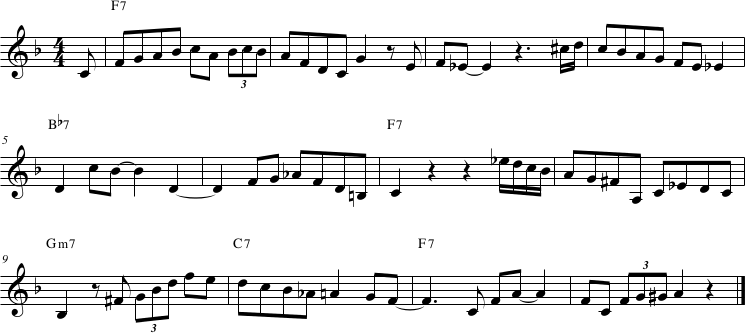[Monday Notes n.11] Let’s listen to one of young Charlie Parker’s first recordings with the orchestra of pianist and blues singer Jay McShann, dated 1940, a piece entitled The Jumping Blues.
Charlie Parker and Jay McShann were both from Kansas City, from where many orchestras with a strong blues imprint and a very particular way of keeping time, marking all four accents of the measure, came. The most famous Kansas City orchestra was Count Basie’s.
The Jumping Blues opens with a typically bluesy piano introduction. This is followed by the theme performed by the orchestra (minute 0’32”). We can then appreciate Charlie Parker’s solo (minute 1’04”) which lasts only twelve measures, that is one blues verse. Here is the transcription of the solo that Charlie Parker plays on The Jumping Blues.

The solo opens with a phrase that is the same as the beginning of Ornithology, a piece that Charlie Parker would write a few years later. In the short space of 12 measures we can immediately appreciate some elements of the tight style that would be fully realised in bebop.
Observe, for example, the use of triplets within chromatic phrases (measures 1,9,12), the rippling of phrases into denser and faster sixteenth-notes passages (measures 3,6) and also Charlie Parker’s energy at the end of the solo, when pianist-singer Jay McShann has to force his way through to silence the saxophonist, who did not seem to want to end the solo (minute 1’20”).
Apart from the solo by the young Charlie Parker, the song is also interesting for the famous riffs typical of Kansas City orchestras, which can be heard from minute 2’18” onwards.
If early jazz had its most important place of origin in New Orleans, the later era of the big bands owed much to Kansas City and its orchestras. It was in these orchestras that musicians who took jazz even further, such as Dizzy Gillespie and Charlie Parker himself, had their experiences.
This is why The Jumping Blues and Charlie Parker’s solo anticipating Ornithology are a very interesting document, which helps us to understand how Charlie Parker already had clear ideas about the music he wanted to play.
Until next Monday!


